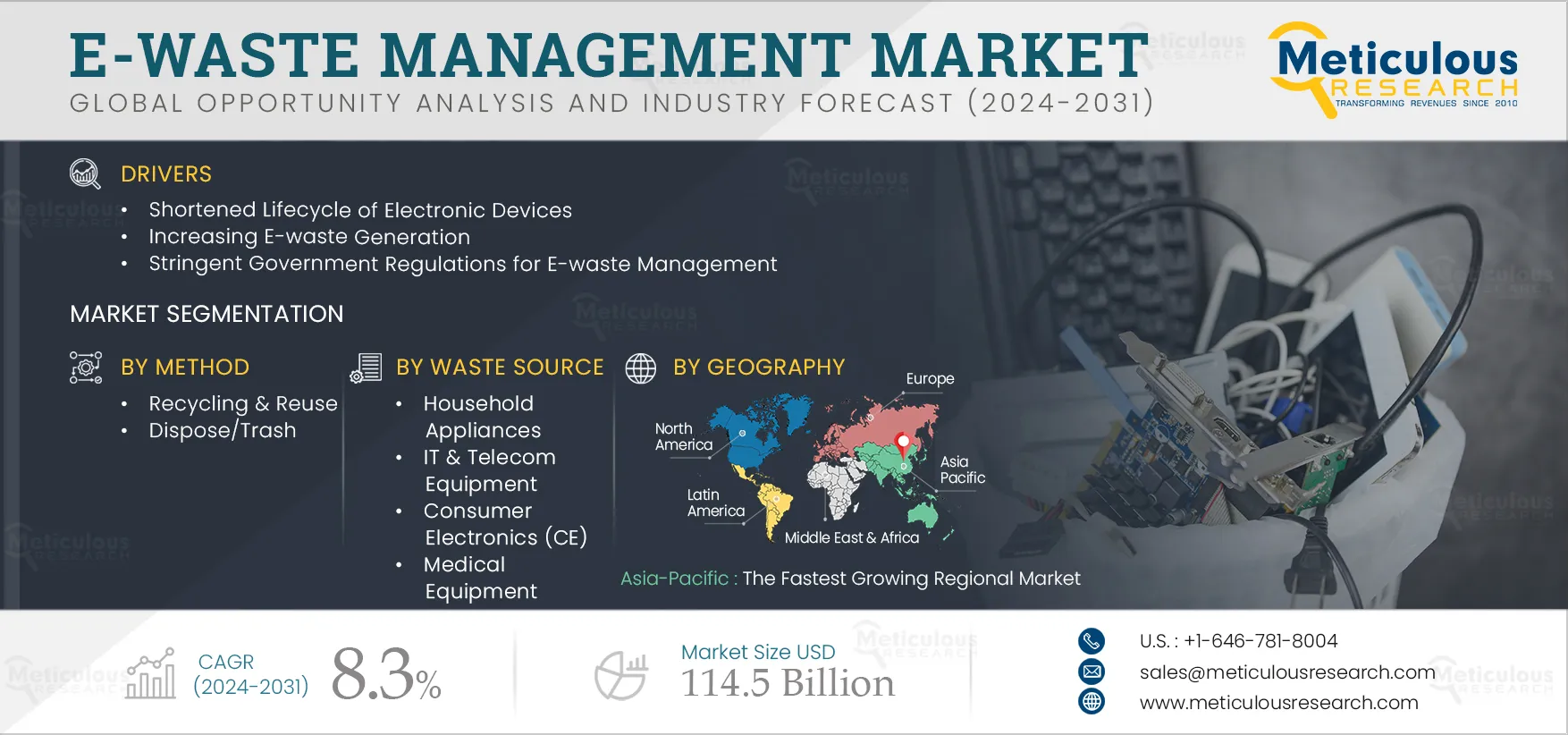The E-waste Management Market is expected to grow at a CAGR of 8.3% during 2024-2031 to reach $114.5 billion by 2031. The electronics industry is the world’s largest and fastest-growing industry. The growing consumer inclination towards adoption of technologically advanced electronic products and constant consumer demand for the latest version of e-devices have led to shorter lifespan of electronic devices as compared to a decade ago. At the same time, this has also led to the rise in the amount of e-waste generated, each day. Along with higher rate of e-waste generation, there is growing awareness about the hazardous effects of e-waste on environment. Which in turn is driving the growth of the e-waste management market during the forecast period. Government regulations and guidelines pertaining to e-waste management are also driving e-waste recycling & reuse programs across the world. An increasing number of electronic manufacturers are now defining their strategies for proper disposal or recycling of e-waste, which is expected to contribute to the growth of the e-waste management market during the forecast period.
Here are the top 10 companies operating in the E-Waste Management Market
Aurubis AG (Germany)
Founded in 1866 and headquartered at Hamburg, Germany; Aurubis AG processes complex metal concentrates, scrap metals, and metal-bearing recycling materials into metals, mainly non-ferrous metals. The company operates through two business segments namely metal refining & processing (MRP), and flat-rolled products.
The company has its geographic presence across North America, Europe, and Asia.
Umicore (Belgium)
Founded in 1989 and headquartered at Brussels, Belgium; Umicore is engaged in providing clean-mobility solutions for various industries like energy, automotive, chemicals, electronics, and manufacturing of clean technologies-based solutions. The company operates in three business segments namely; recycling, energy & surface technologies, and catalysis.
The company has its geographic presence across North America, Europe, Asia Pacific, Latin America, and Middle East and Africa.
Sims Metal Management Limited (U.S.)
Founded in 1917 and headquartered at New York, U.S.; Sims Metal Management Limited carries out metal recycling process and provides ferrous and non-ferrous recycled metals. The company operates in six segments namely North America Metals (“NAM”), Australia/New Zealand Metals (“ANZ”), UK Metals (“UK”), Global Trading, Investment in SA Recycling (“SAR”) and Global E-Recycling (“E-Recycling”).
The company has its geographic presence across North America, Europe, Asia Pacific, Latin America, and Middle East and Africa.
Boliden (Sweden)
Founded in 1931 and headquartered at Stockholm, Sweden; Boliden is a majorly involved in providing high-quality metals to industrial customers. The company is among global leaders in the field of electronics recycling. The company operates into two business segments namely Business Area Mines and Business Area Smelters; and has geographic presence mainly across Sweden, Finland, Norway and Ireland
Stena Metall Group (Sweden)
Founded in 1939 and headquartered at Masthuggskajen, Sweden; Stena Metall Group operates in eight business areas namely recycling, aluminum, electronics recycling, oil, steel, components, trading, and finance.
The company has its geographic presence across Sweden, Norway, Denmark, Finland, Poland, Switzerland, Malta, Germany, Italy and the U.S.
Tetronics (International) Limited (U.K.)
Established in 1964 and headquartered in Wiltshire, U.K.; Tetronics (International) Limited is a global leader in the waste recovery industry. The company offers waste management solutions to construction, metal refining, nuclear, oil and gas, chemical, and other industries. The company’s plasma recovery technology for e-waste management offers solutions for recovering metals from electronic waste.
The company has its geographic presence across North America, Europe and Asia.
Electronic Recyclers International, Inc. (U.S.)
Founded in 2002 and headquartered at California, U.S.; Electronic Recyclers International, Inc. (ERI) provides solutions to de-manufacture and recycle & refurbish every type of electronic device, with cybersecurity-focused hardware destruction. The technologies and techniques used by the company are; flat panel shredder system, CRT glass separation and processing, tracking and reporting portal, USB local data wipe solutions and mail back recycling kit program for collection of batteries, lamps, and electronics.
Enviro-Hub Holdings Ltd. (Singapore)
Founded in 1998 and headquartered in Tuas, Singapore; Enviro-Hub Holdings Ltd. works as an investor in management of commercial and industrial properties, trading of ferrous and non-ferrous metals, electronic waste (e-waste), e-waste recycling, platinum refining, piling, and construction works. The Group operates into four reportable segments namely property investments and management; trading, recycling and refining of e-waste/metals; piling contracts, construction, rental and servicing of machinery; and others.
The company has a strong geographic presence mainly in Singapore, Hong Kong & China, Europe, Malaysia, & other countries.
TRIPLE M METAL LP (Canada)
Founded in 1975 and headquartered at Ontario, Canada; TRIPLE M METAL LP operates as a metal recycling company. The company provides services for recycling of ferrous and non-ferrous scrap metals. It is among leading suppliers of services pertaining to transforming scrap into metal stampings, turnings, plates, extrusions, sheets, wires, bars, pipes, tubes and rods.
The company has its geographic presence across North America, including Canada, U.S., Mexico; and Europe.
Global Electric Electronic Processing (GEEP) (Canada)
Founded in 1985 and headquartered at Ontario, Canada.; Global Electric Electronic Processing (GEEP) is a global leader in management of the complete lifecycle of IT assets through electronic asset management and end-of-life electronics recycling. The company specializes in Electronics Asset Disposition in every industry by offering service solutions to reuse and recycle electric and electronic equipment waste.
Popular Mentions: Canada, Costa Rica, Michigan, North Carolina, Barrie, Calgary, Edmonton, Montreal, Toronto, and Vancouver.
























